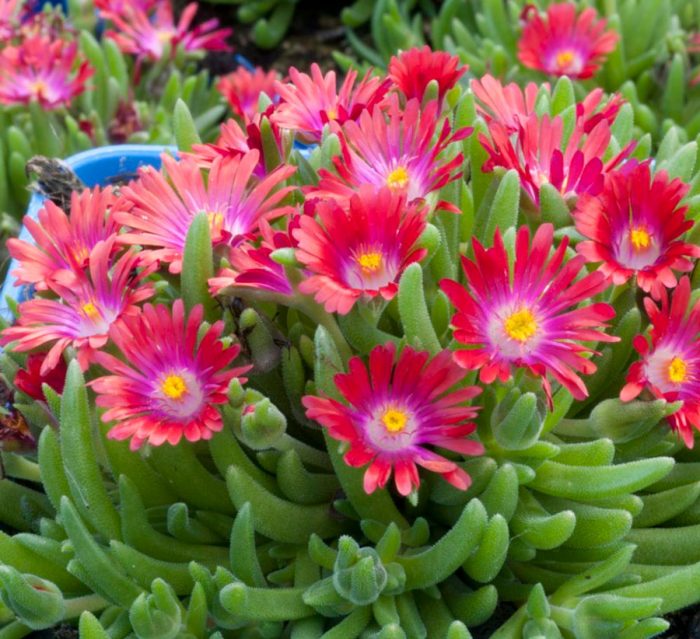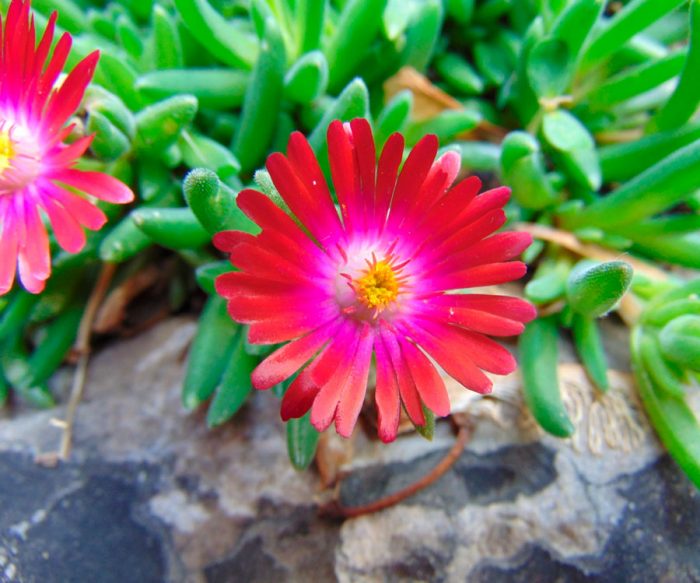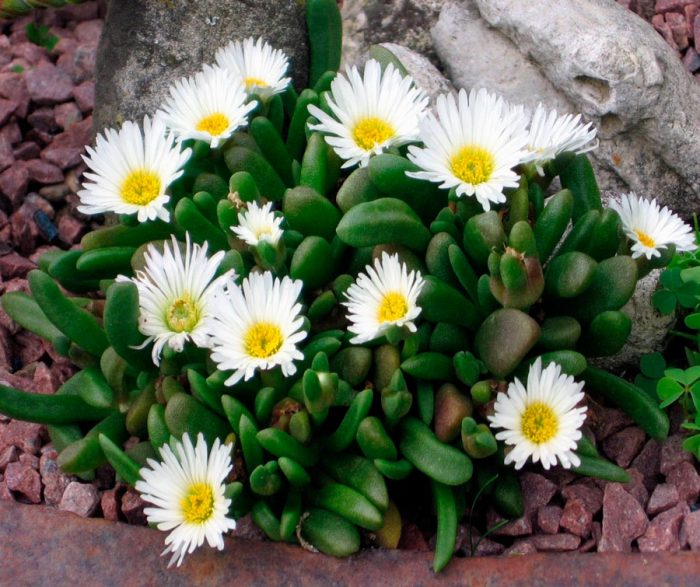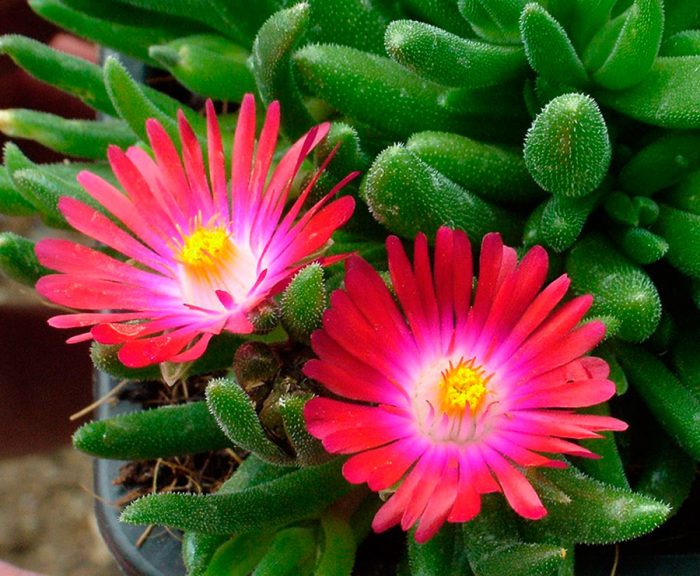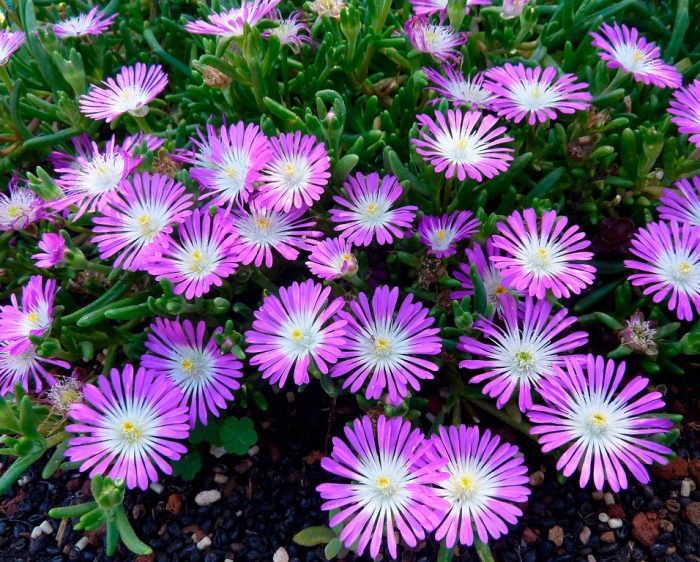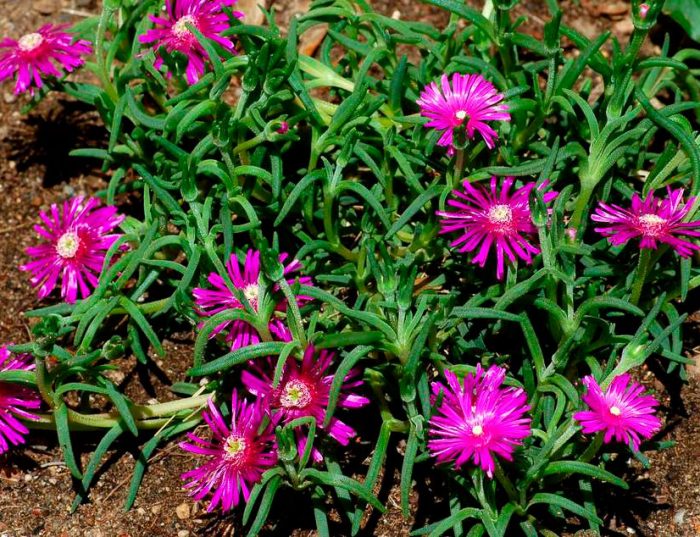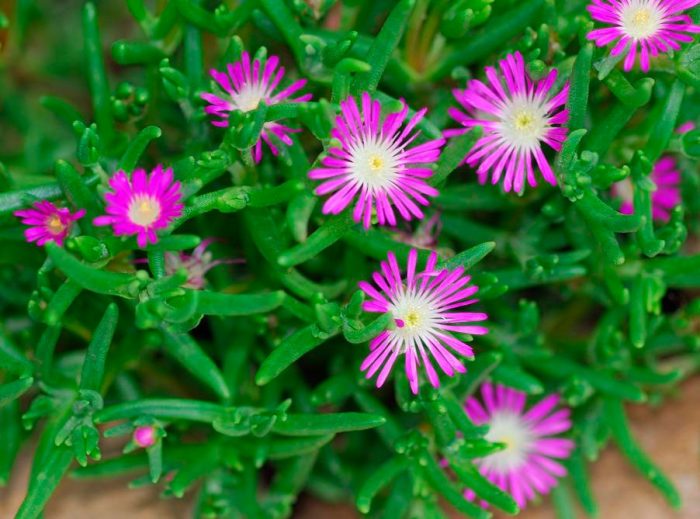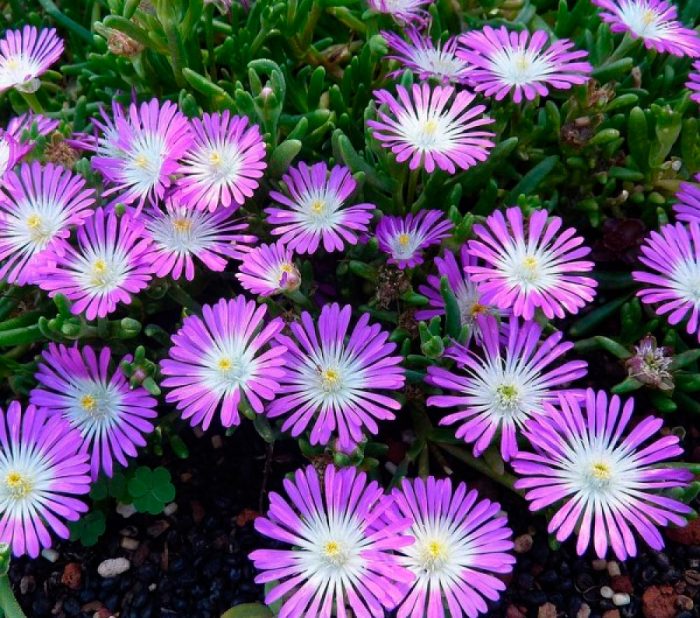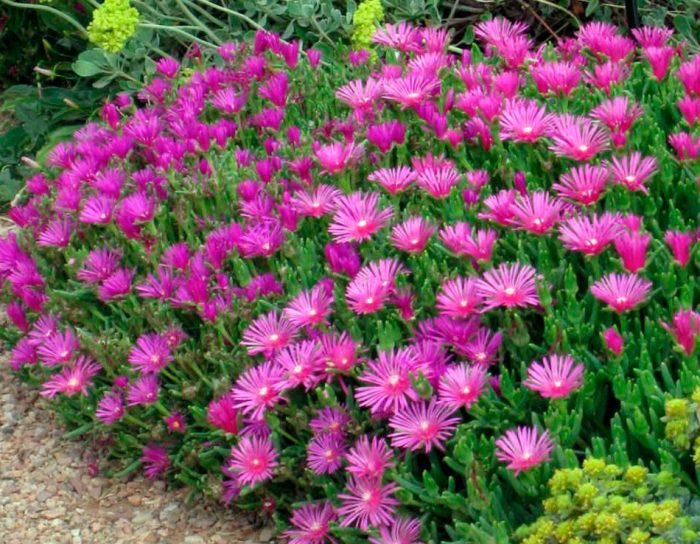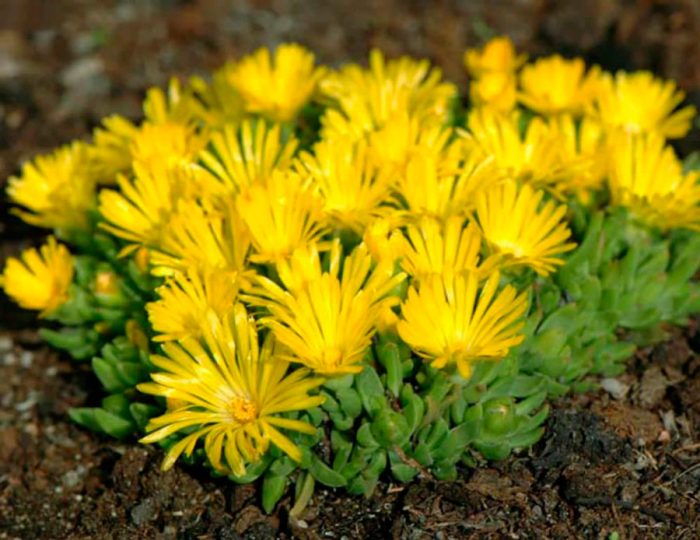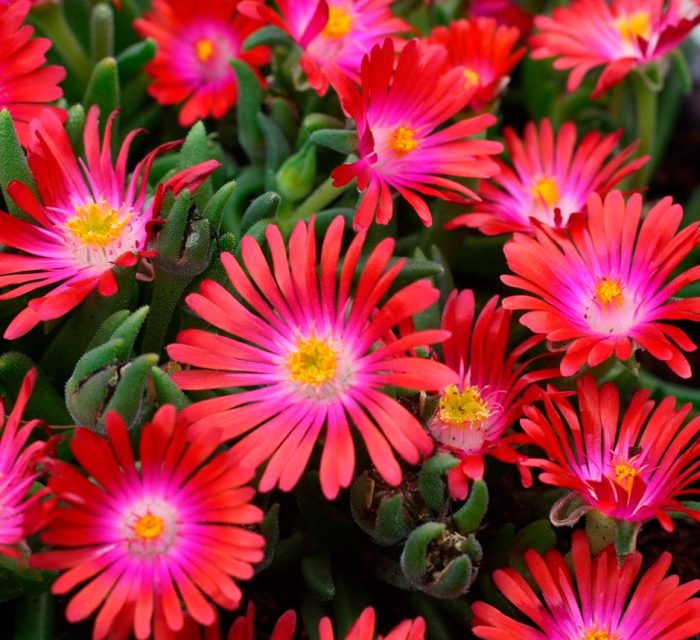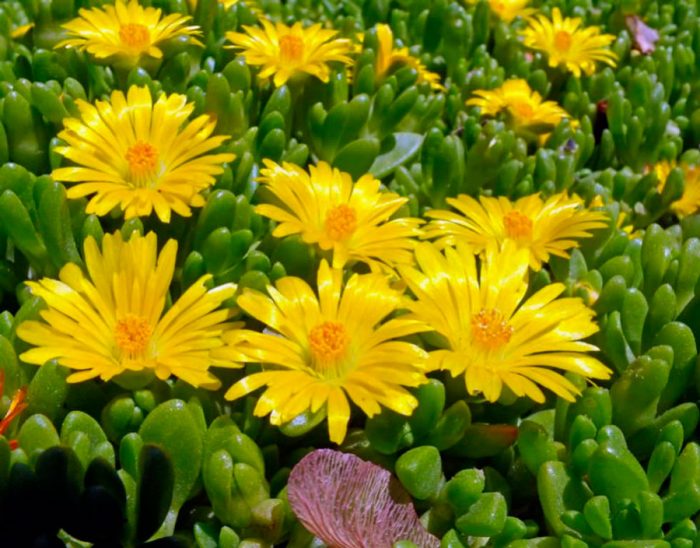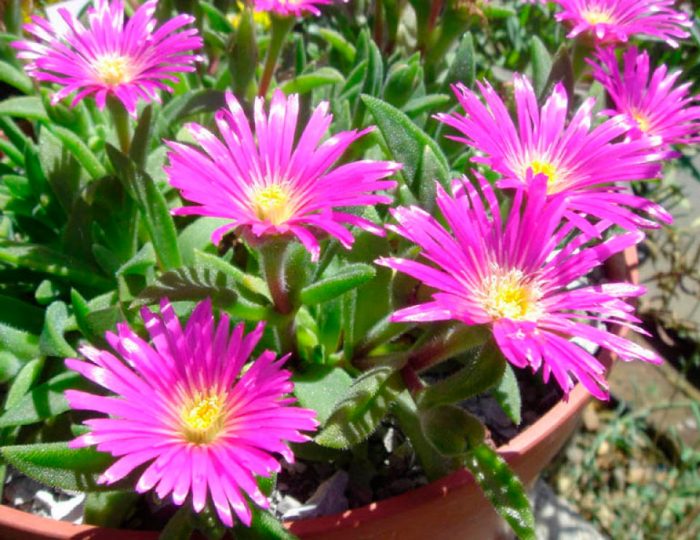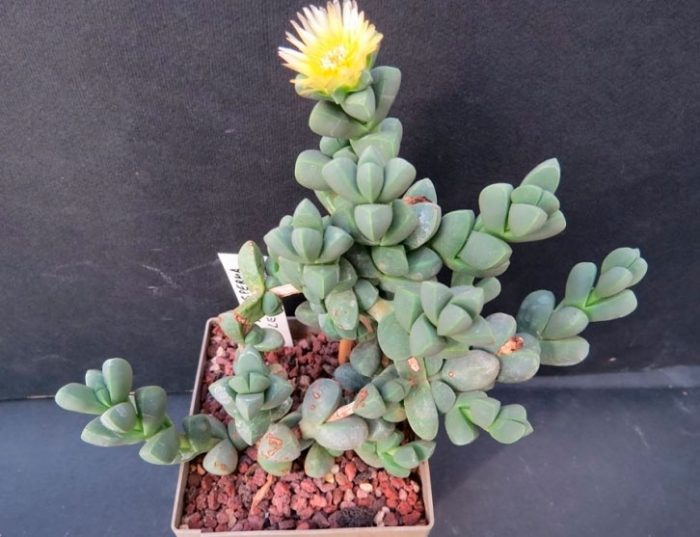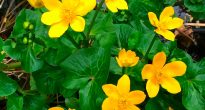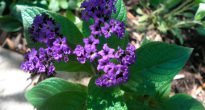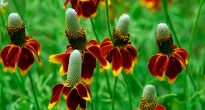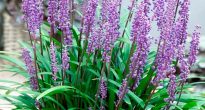The delosperm plant is a semi-shrub succulent with a variety of shapes and colors. This unusual cover plant is used to create dramatic curbs, alpine slides and flower beds.
Delosperma, when well cared for and growing conditions, can beautify both your garden and your home for many years. When choosing a variety of this succulent, you need to consider where exactly you will grow it. At home, almost all species and varieties, even the most thermophilic, will feel normal. At the same time, it is recommended to choose the varieties and species most resistant to frost for growing in the garden. The flowering of this culture occurs in the spring and summer.
Content
- 1 Delosperm care
- 2 Reproduction methods
- 3 Landing in open ground
- 4 Diseases and pests
- 5 Wintering features
- 6 Types of delosperm with photos
- 6.1 Delosperma profusely flowering (Delosperma floribundum)
- 6.2 Delosperma Stardust
- 6.3 Delosperma Cooperi
- 6.4 Twisted Delosperma (Delosperma Congestum)
- 6.5 Delosperma Tradescantioides
- 6.6 Delosperma Dyeri
- 6.7 Delosperma Jewel
- 6.8 Delosperma Cloudy (Delosperma Nubigenum)
- 6.9 Delosperma Sutherlandii
- 6.10 Delosperma Lehmannii
Delosperm care
Seat selection
To place the delosperma in your garden or at home, you should choose the sunniest and warmest place. It is resistant to both too high temperatures and excessive drought. In fleshy, dense foliage, this succulent stores moisture, which is used by the plant when needed. The flower reacts extremely negatively to the stagnation of liquid in the soil. This can cause the development of disease or even death of the plant.
Watering rules
Watering such a succulent should be done only in the morning. During active growth and flowering, it is necessary that the surface of the soil dries out a little between watering. The watering regime directly depends on the season and growing conditions. But it should be remembered that in no case should moisture stagnate in the roots of Delosperm.
If you take indoor delosperm in a pot outside during the warm season, then protect it from the rain. This will help avoid liquid stagnation in the ground. During the dormant period, bushes grown indoors are watered only when the substrate in the pot dries out to a depth of ½ part.
Illumination
For planting such a light-loving culture in the garden, open and well-lit areas should be chosen.The bush should be illuminated by the sun from morning to evening. When growing indoors for a flower, you should choose a southern, southwestern or southeastern window sill. At the same time, remember that direct sunlight is necessary for such succulents for development and growth within normal limits. In southern regions, where the sun is most active, both indoor and garden bushes should be shaded in the afternoon.
If you choose a place in the shade or in shade for growing delosperm, then it will not be able to grow normally. Its shoots will become elongated and thin, and the gardener will also be saddened by the lack of flowering.
Temperature regime
In the warm season, the succulent tolerates short heat well (about 40 degrees). At the same time, he feels best during this period at a temperature of about 27 degrees.
In winter, it is recommended to move indoor delosperm to a cooler place (from 7 to 10 degrees). At the same time, both a decrease and an increase in air temperature in winter are permissible only for a short time.
Air humidity
The bush can grow in any humidity. However, on hot days in summer, it is better to moisturize the space around the plant with a sprayer.
Suitable soil
In order for this succulent plant to grow well, suitable soil should be selected for planting it:
- it is important that it be loose and light, in this case the root system will grow and develop well;
- it must pass water and air well (this will exclude the development of rot due to stagnation of liquid in the substrate);
- should contain a small amount of nutrients;
- should have low acidity (maximum allowable pH - 6.5).
In order to make a substrate for planting delosperm with your own hands, it is necessary to combine sod soil, perlite and leaf humus. Charcoal and brick chips are added to the finished mixture, while they are taken in 1/10 part of the total mass of the substrate. After the bush is planted in a pot, the surface of the substrate is covered with small stones or sphagnum. This will help to reduce the number of waterings, since moisture from the soil mixture will evaporate much longer.
Transfer
When grown indoors, a flower is transplanted only when absolutely necessary. For example: the root system does not fit in the pot or rot has appeared on it, as well as damage to the plant by diseases or pests. It is best to replant the bush in the spring before the growing season begins.
Top dressing
It is necessary to feed indoor delosperma only if it grows in the same soil mixture for more than 2 years. For this, a mineral complex is used, which is dissolved in water before being added to the substrate. In this case, it is enough to take ½ part of the dosage that is recommended in the instructions.
Please note that the oversaturation of the soil mixture with nutrients must not be allowed. Otherwise, the stems will become overly elongated and the flowering will be extremely poor. As a rule, feeding is carried out from the second half of April to mid-July. In this case, fertilizers are applied to the substrate 1 time in 20 days.
Pruning
Prune or pinch this succulent only if necessary. As a rule, this procedure allows:
- accelerate growth: in this case, the upper part of the longest shoots is cut off;
- prolong flowering: cut off wilted flowers in time;
- to increase decorativeness: for this, all stems and leaf plates that have withered, dried up or are affected by a disease are removed from the bush;
- improve survival rate after transplanting: remove all lower leaf plates from seedlings or cuttings.
Bloom
Such a succulent plant blooms for a very long time. The opening of the first flowers is observed in the last spring weeks. In this case, the bushes will be decorated with flowers until late autumn. Despite the fact that the flowers are solitary, the plants form spectacular bright "carpets".This is possible due to the fact that many buds are formed on one stem. Quite large flowers look very impressive.
The center of the flower is spherical and filled with small petals. The center of the flower is framed with oblong petals, which are placed very densely in one or several rows. They can be painted in various shades: from bright purple to snow-white. There are varieties in which there is a smooth transition from one color to another in each flower.
Important! Remember that flowers unfold only when the sun is shining.
Reproduction methods
As a rule, flower growers and gardeners propagate delosperma mainly in two ways: seed (through seedlings) and cuttings.
Growing from seeds
Sowing seeds for seedlings, which will then be transplanted into open ground, is recommended in mid-January. In this case, by the time of planting, the seedlings will have time to get stronger and bloom very early.
Take a container and fill it with peat soil. Spread the seed over the surface and cover it with a not too thick layer of snow. As the snow melts, the resulting water will be absorbed into the soil mixture, carrying the seeds along with it. From above, the container should be closed with glass or foil, after which it is placed in a place where it is always cool for 15 days. Then the crops are transferred to a well-lit place.
After the first seedlings appear, the shelter is removed. Moisten the substrate from the sprayer as it dries, and do not allow the liquid to stagnate in the container. It is necessary to cut the grown bushes into separate cups after they have formed 2 or 3 pairs of true leaf plates. With the onset of heat, the bushes are planted in the garden if necessary, do not forget to harden them first. At the same time, remember that even small frosts can destroy the seedlings.
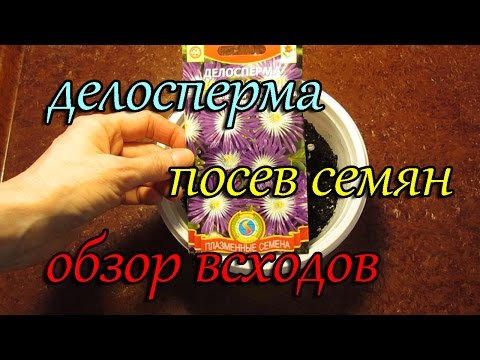

Watch this video on YouTube
Cuttings
Delosperm stems form roots in places where they come into contact with the ground. If necessary, you can cut off a stalk from such an shoot with regrown roots. Moreover, this procedure can be carried out throughout the entire growing season. And if the bush grows in the house, then you can propagate it by cuttings all year round.
Cut off an area with roots and foliage from the shoot. The resulting stalk can be planted immediately in a flower garden or in an individual pot. He will quickly take over and start growing.
If there are no roots on the stems, then several cuttings are cut with a length of no more than 75 mm. They are left in the open air for a couple of hours so that the cut sites have time to dry well. The container is filled with cactus potting soil or sand. Then 1 cutting is planted in it, which is immediately transferred to a sunny windowsill. Water the cuttings sparingly and only if necessary, while making sure that moisture does not get on the plant and does not stagnate in the substrate. The roots of the segment will appear after a few days.
You can also use a container filled with water to root delosperm cuttings. When the roots appear, the young plant is planted in a pot with a substrate or in a garden.
Landing in open ground
The soil in the flower garden should be loose and fertile, as well as well-drained. In order for it to better allow air and water to pass through, it is dug up with the introduction of sand or peat. When planting plants in the garden, a distance of about 50 cm should be observed between them. So much space is needed for the flower due to the fact that its ground, as well as the underground part, grows very quickly.
Diseases and pests
Delosperma is quite resistant to pests and diseases. However, if liquid stagnates in the soil, for example, due to frequent watering or too dense soil, then because of this, the flower may rot.
Of the pests, the following most often settle on the bush:
- Mealybug... The bushes are sprayed with an insecticide solution, the main active ingredient of which is cypermethrin.
- Aphids... If there are few pests, then dissolve half a bar of laundry soap in 5 liters of hot water. When the mixture has cooled, bushes are treated with it.
- Spider mite... Use a cotton swab moistened with soapy water to remove as many pests from the plant as you can. Then it is sprayed with a solution of a chemical or biological acaricide.
Wintering features
In home
In winter, room delosperm has a dormant period. At this time, it is placed in a cool place (10-12 degrees). Watering should be sparse and sparse (about 1 time in 30 days), while do not overdry the soil mixture in the pot.
There is no need to feed the bushes in winter, otherwise they will not stop growing. However, the shoots that appear will be thin, weakened and elongated. If the flower is warm in winter, then it must be provided with a large amount of light so that it does not lose its spectacular appearance.
In the garden
In open soil, the bushes can withstand a drop in air temperature to minus 15-20 degrees. So that during the thaw the bush does not rot from an excess of moisture, you will need a special shelter. There are several options:
- the site is covered with a layer of dry foliage and spruce branches;
- above each bush a wooden box turned upside down is placed;
- a frame is made on which the film and insulation are stretched.
You can also dig a bush in the fall, plant it in a pot and bring it into the house. Annual delosperms in spring are grown from cuttings, which are cut from the overwintered bush.
Types of delosperm with photos
The genus delosperm includes about 100 different species and forms. Most of them are heat-loving plants that are cultivated only in indoor conditions. However, among them there are also quite frost-resistant species with which you can decorate your garden plot.
Delosperma profusely flowering (Delosperma floribundum)
This plant is especially beautiful in summer, when it is decorated with numerous inflorescences. In diameter, the flowers reach a little less than 30 mm. They have a very spectacular color: the white center has a purple or pink frame, consisting of oblong petals. The flowering of the bush is observed in the year of planting. Due to this, this species is often cultivated as an annual plant.
Delosperma Stardust
This perennial is used to decorate the garden. Please note that it must be covered well for the winter. It should be borne in mind that it is able to withstand a temperature drop of more than minus 20 degrees. The middle of the flowers is white, and the tops of their long petals are colored pink. There are varieties with purple-lilac flowers.
Delosperma Cooperi
The height of a strongly branching bush is no more than 15 cm, while in diameter it can reach almost 50 cm. It is not afraid of frosts down to minus 17 degrees. The creamy yellow center is framed by silky shiny petals. The flowers are relatively large: they reach about 50 mm in diameter.
Twisted Delosperma (Delosperma Congestum)
This plant is highly resistant to frost (up to minus 20 degrees). Shoots with lush green foliage form a dense canopy. During flowering, the entire bush is covered with rich yellow flowers. It blooms, as a rule, in May. With the onset of autumn, the foliage changes its color to burgundy.
Delosperma Tradescantioides
The species is distinguished by long stems that spread over the soil surface. If the bush grows on a hill, then its shoots will hang down effectively. Outwardly, this plant is very similar to Tradescantia. It is decorated with pale green foliage and small snow-white flowers.
Delosperma Dyeri
This hybrid plant has an unusual peach color. It is widely cultivated at home. Differs in good winter hardiness (frosts up to minus 29 degrees are not terrible).There are many varieties that differ from each other in the color of the flowers.
Delosperma Jewel
This species has several varieties that differ in the shade of flowers:
- Desert Pearl Pomegranate (Jewel of D. Garnet) - pinkish-white center of the flower is surrounded by pomegranate petals;
- the pearl of the desert Opal (Jewel Of Desert Opal) - the color of the flowers is lilac;
- Desert pearl Ruby (Jewel of D. Ruby) - the bush is decorated with spectacular purple-red flowers.
Delosperma Cloudy (Delosperma Nubigenum)
This species has creeping stems that are capable of forming a green carpet. In height, such an evergreen plant can reach about 10 cm. It is not afraid of frosts down to minus 23 degrees. Small flowers are colored bright yellow or deep orange.
Delosperma Sutherlandii
On the surface of the stems and foliage, there is a gentle pubescence. During the flowering period, relatively large flowers of a bright lilac hue open on a undersized bush, while their middle is pale yellow. It is characterized by a fairly high resistance to frost (up to minus 23 degrees).
Delosperma Lehmannii
This variety is quite widespread in indoor culture. It has spectacular foliage that looks like a triangular pyramid. The flowers are painted in a pale yellow shade.
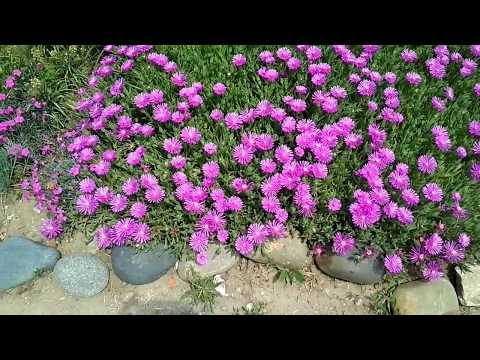

Watch this video on YouTube


